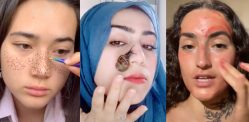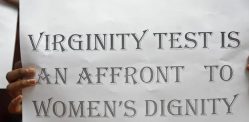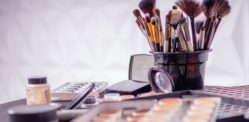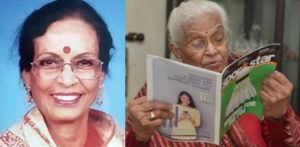Western society has glorified tanning.
Fake tanning is a beauty trend that has sky-rocketed in popularity in the recent decade with a dramatic expansion of the industry.
With even more individuals starting to use fake tan at younger ages in their lives, it appears bronzed skin is also becoming a new beauty standard.
However, has this increased usage and popularity of fake tan caused it to become a problematic beauty ideal?
DESIblitz looks at the beauty trend and how it has turned into a problematic standard.
What is Fake Tanning?

Fake tan itself is an artificial suntan that allows individuals to gain the benefits of a suntan without actual exposure to the sun.
It often involves using oral agents, creams, lotions, sprays, and other skin-applied products that leave a tan-like pigment on the skin.
Fake tan can easily be removed with removers and washed out which defiantly draws individuals into the beauty trend.
It allows users to easily manipulate a skin tone that they currently don’t have and remove it when they no longer want it.
Some examples of brands include Bondi Sands, St. Tropez, Coco and Eve, and Filter by Molly Mae.
The industry has become a vast and expansive industry with over a hundred fake-tanning-based businesses in the UK alone.
The beauty practice has even been used in various TikTok trends to seem naturally bronzed and even toned in individuals’ daily lives with people using self-tan as face contour and as ab or muscle, contour to enhance the appearance of muscles.
Is it Safe?

In an interview with beauty brand Coco and Eve, dermatologist Dr Zokaie said:
“Fake tanning is safer than using sunbeds or sunbathing which has the risk of sunburns and premature photo ageing and risk of developing skin cancer in the future.”
Fake tanning has amassed interest as a safer alternative than using sunbeds or lying out in the sun which exposes us to harmful UV rays as medical professionals have described.
Most fake-tanning products and sprays both contain a chemical called DHA, which is the chemical that creates the appearance of tanned skin.
DHA is essentially a sugar mixed with amino acids that combine to provide the glow in fake tanning products and has been deemed as a non-toxic ingredient.
However, as with any chemically infused beauty product, there are still risks albeit since DHA is still a chemical, it should only be used in low concentrations and not overused as studies have shown that inhaling DHA can be toxic and alter DNA.
This means using fake-tanning lotions may be a safer alternative than spray tans as you are less likely to inhale DHA fumes by applying them on the surface of the skin.
However, individuals should always patch-test skin-applied products to avoid allergic reactions, especially if they have sensitive skin.
Though the dangers of fake tanning don’t lie massively in its health aspects, there do appear to be social dangers that accompany the overuse of fake-tanning products within mainstream culture.
Why is Fake Tanning so Popular?

Many fake-tan businesses are ruling the beauty industry and selling thousands of products daily as they are advertised not only in drugstores but supermarkets, salons, and plenty of online retailers.
The phenomenon behind fake tan has not only been about appearance but for many, it has improved their mental well-being and confidence.
Erin Fox, a 21-year-old fake-tan user said:
“I like self-tanning as a way to give you that holiday glow and it can help you feel more confident in your own skin, however, I do think some people take it too far when they look orange or worse when it appears like they’re black fishing.”
Perceptions of tan have fluctuated over the centuries with Western society and certain cultures having previously stereotyped individuals with darker skin tones.
In previous centuries like the Victorian age, those who were tanned were thought of as déclassé since bronzed skin was associated with workers who laboured in the sun whilst upper-class individuals were shaded by parasols.
However, Western society has now glorified tanning, bronzed skin has become a staple beauty standard and fake tan products are being promoted by celebrities and influencers.
Celebrities known for using fake tan include Blake Lively, Bella Hadid, Kim Kardashian and Molly Mae, the Love Island star who owns a beauty brand.
Her brand, Filter by Molly Mae, had Love Island fans and beauty enthusiasts hyped to try the products when it first launched in 2019.
There are now many celebrities and influencers like Molly who are advocating for and creating brands selling mousses, tanning drops, lotions, and a variety of different skin-applied products.
The market is now worth millions in Britain alone, with it being worth ten times that globally.
Is the Beauty Trend Problematic?

However, some people grew up being taunted for their darker complexions that don’t see fake tanning as a simple trend.
25-year-old Ashna Parul said:
“Fake tanning appears to me as fetishization when people are wanting the golden hues of darker skin but don’t want the burden and racism that can sometimes come with it in this society.”
The beauty ideal of golden skin can therefore be problematic when it fetishizes the skin colour that people of colour naturally have.
However, not everyone thinks fake tan is necessarily bad, instead believing that the beauty trend needs to have its limits.
22-year-old medical student Deena Rai said:
“I personally don’t see an issue with women using it to fake a natural tan for their skin complexion, however, I don’t think it’s right when people overuse it and basically change race.”
Celebrities like Kim Kardashian and Jesy Nelson have often been accused of over-tanning to the point where individuals are calling them out for black fishing.
Therefore, the overuse of it can be perceived as offensive as those with naturally darker complexions have endured years of oppression over their complexion.
Thus, whilst the trend may be safer than direct UV exposure, it can be problematic when overused.
Using fake tan itself is not the problem, however, when it is overused, unnatural and overly glorified, it tends to become a problematic beauty ideal and calls into question the motives behind using it.
However, due to its rapid growth and increased global popularity, it doesn’t seem like the beauty trend is going anywhere anytime soon.
Whilst the beauty standard continues to impact more individuals, one can only hope that attitudes change regarding the overuse of the product.





























































